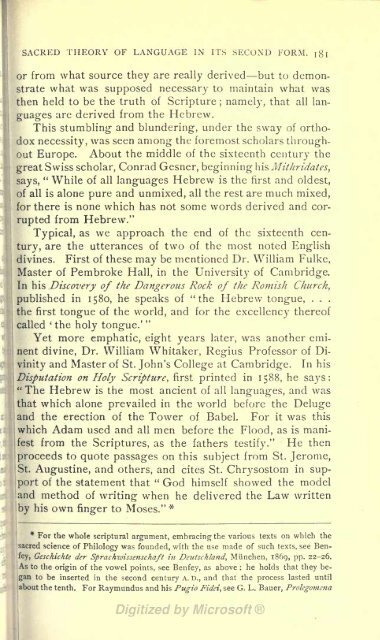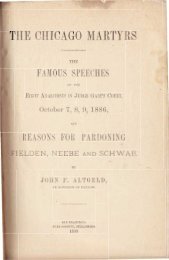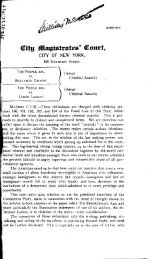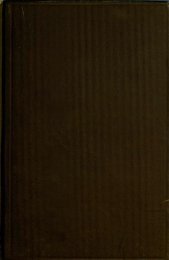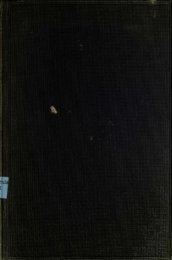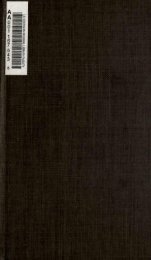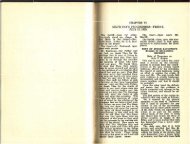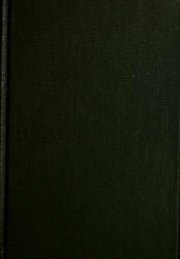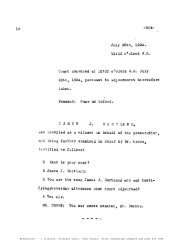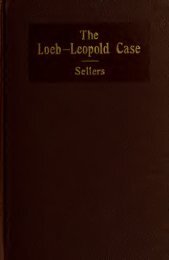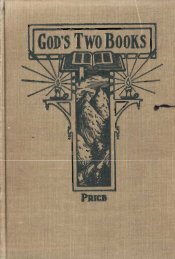- Page 4 and 5:
(9?) A HISTORY OF JS^ THE WARFARE O
- Page 6 and 7:
CONTENTS OF THE SECOND VOLUME. CHAP
- Page 8 and 9:
CONTENTS OF THE SECOND VOLUME. Theo
- Page 10 and 11:
CONTENTS OF THE SECOND VOLUME. vii
- Page 12 and 13:
CONTENTS OF THE SECOND VOLUME. Jx P
- Page 14 and 15:
CONTENTS OF THE SECOND VOLUME. xi P
- Page 16:
CONTENTS OF THE SECOND VOLUME. xiii
- Page 19 and 20:
, broadly 2 FROM MIRACLES TO MEDICI
- Page 21 and 22:
A FROM MIRACLES TO MEDICINE. St. Jo
- Page 23 and 24:
6 FROM MIRACLES TO MEDICINE. missio
- Page 25 and 26:
8 FROM MIRACLES TO MEDICINE. lished
- Page 27 and 28:
lO FROM MIRACLES TO MEDICINE. desti
- Page 29 and 30:
12 FROM MIRACLES TO MEDICINE. telle
- Page 31 and 32:
14 FROM MIRACLES TO MEDICINE. Here,
- Page 33 and 34:
1 6 FROM MIRACLES TO MEDICINE. his
- Page 35 and 36:
1 8 FROM MIRACLES TO MEDICINE. It s
- Page 37 and 38:
20 FROM MIRACLES TO MEDICINE. the s
- Page 39 and 40:
22 FROM MIRACLES TO MEDICINE. These
- Page 41 and 42:
24 FROM MIRACLES TO MEDICINE. lish
- Page 43 and 44:
26 FROM MIRACLES TO MEDICINE. find
- Page 45 and 46:
28 FROM MIRACLES TO MEDICINE. that
- Page 47 and 48:
\ 30 FROM MIRACLES TO MEDICINE. agi
- Page 49 and 50:
32 FROM MIRACLES TO MEDICINE. blow
- Page 51 and 52:
34 FROM MIRACLES TO MEDICINE. princ
- Page 53 and 54:
36 FROM MIRACLES TO MEDICINE. medic
- Page 55 and 56:
38 FROM MIRACLES TO MEDICINE. Magic
- Page 57 and 58:
40 FROM MIRACLES TO MEDICINE. As to
- Page 59 and 60:
42 FROM MIRACLES TO MEDICINE. the s
- Page 61 and 62:
44 FROM MIRACLES TO MEDICINE. Still
- Page 63 and 64:
46 FROM MIRACLES TO MEDICINE. Yet L
- Page 65 and 66:
48 FROM MIRACLES TO MEDICINE. by th
- Page 67 and 68:
50 FROM MIRACLES TO MEDICINE. Arago
- Page 69 and 70:
52 FROM MIRACLES TO MEDICINE. asked
- Page 71 and 72:
54 FROM MIRACLES TO MEDICINE. favou
- Page 73 and 74:
FROM MIRACLES TO MEDICINE. fensible
- Page 75 and 76:
58 FROM MIRACLES TO MEDICINE. The s
- Page 77 and 78:
6o FROM MIRACLES TO MEDICINE. of th
- Page 79 and 80:
62 FROM MIRACLES TO MEDICINE. ; agu
- Page 81 and 82:
64 FROM MIRACLES TO MEDICINE. of di
- Page 83 and 84:
66 FROM MIRACLES TO MEDICINE. H tha
- Page 85 and 86:
68 FROM FETICH TO HYGIENE. thought.
- Page 87 and 88:
'JO FROM FETICH TO HYGIENE. tain Ca
- Page 89 and 90:
72 FROM FETICH TO HYGIENE. spectful
- Page 91 and 92:
74 FROM FETICH TO HYGIENE. Yet, as
- Page 93 and 94:
1^ FROM FETICH TO HYGIENE. ducing t
- Page 95 and 96:
78 FROM FETICH TO HYGIENE. yet here
- Page 97 and 98:
8o FROM FETICH TO HYGIENE. were wil
- Page 99 and 100:
82 FROM FETICH TO HYGIENE. I II. GR
- Page 101 and 102:
84 FROM FETICH TO HYGIENE. and abou
- Page 103 and 104:
86 FROM FETICH TO HYGIENE. death's
- Page 105 and 106:
88 FROM FETICH TO HYGIENE. ories we
- Page 107 and 108:
90 FROM FETICH TO HYGIENE. poses fr
- Page 109 and 110:
Q2 In the army generally FROM FETIC
- Page 111 and 112:
94 FROM FETICH TO HYGIENE. palaces
- Page 113 and 114:
96 FROM FETICH TO HYGIENE. p. 134 ;
- Page 115 and 116:
gS FROM "DEMONIACAL POSSESSION" TO
- Page 117 and 118:
lOO FROM "DEMONIACAL POSSESSION" TO
- Page 119 and 120:
I02 FROM "DEMONIACAL POSSESSION" TO
- Page 121 and 122:
I04 FROM "DEMONIACAL POSSESSION" TO
- Page 123 and 124:
Io6 FROM "DEMONIACAL POSSESSION" TO
- Page 125 and 126:
Io8 FROM "DEMONIACAL POSSESSION" TO
- Page 127 and 128:
no FROM "DEMONIACAL POSSESSION" TO
- Page 129 and 130:
112 FROM "DEMONIACAL POSSESSION" TO
- Page 131 and 132:
114 FROM "DEMONIACAL POSSESSION" TO
- Page 133 and 134:
Il6 FROM "DEMONIACAL POSSESSION" TO
- Page 135 and 136:
Il8 FROM "DEMONIACAL POSSESSION" TO
- Page 137 and 138:
I20 FROM "DEMONIACAL POSSESSION" TO
- Page 139 and 140:
122 FROM "DEMONIACAL POSSESSION" TO
- Page 141 and 142:
124 FROM "DEMONIACAL POSSESSION" TO
- Page 143 and 144:
126 FROM "DEMONIACAL POSSESSION" TO
- Page 145 and 146:
128 FROM "DEMONIACAL POSSESSION" TO
- Page 147 and 148: I30 FROM -'DEMONIACAL POSSESSION" T
- Page 149 and 150: 132 FROM "DEMONIACAL POSSESSION" TO
- Page 151 and 152: 134 FROM "DEMONIACAL POSSESSION" TO
- Page 153 and 154: 136 FROM DIABOLISM TO HYSTERIA. bew
- Page 155 and 156: 138 FROM DIABOLISM TO HYSTERIA. wer
- Page 157 and 158: I40 FROM DIABOLISM TO HYSTERIA. cas
- Page 159 and 160: 142 FROM DIABOLISM TO HYSTERIA. enc
- Page 161 and 162: 144 FROM DIABOLISM TO HYSTERIA. In
- Page 163 and 164: 1^6 FROM DIABOLISM TO HYSTERIA. ado
- Page 165 and 166: 1^8 FROM DIABOLISM TO HYSTERIA. wom
- Page 167 and 168: i;o FROM DIABOLISM TO HYSTERIA. bel
- Page 169 and 170: 152 FROM DIABOLISM TO HYSTERIA. aff
- Page 171 and 172: 154 FROM DIABOLISM TO HYSTERIA. cus
- Page 173 and 174: 156 FROM DIABOLISM TO HYSTERIA. So
- Page 175 and 176: 158 FROM DIABOLISM TO HYSTERIA. Bri
- Page 177 and 178: j6o from diabolism to hysteria. ent
- Page 179 and 180: 1 62 FROM DIABOLISM TO HYSTERIA. th
- Page 181 and 182: 164 FROM DIABOLISM TO HYSTERIA. ing
- Page 183 and 184: l66 FROM DIABOLISM TO HYSTERIA. Joh
- Page 185 and 186: CHAPTER XVII. FROM BABEL TO COMPARA
- Page 187 and 188: I70 FROM BABEL TO COMPARATIVE PHILO
- Page 189 and 190: 1/2 FROM BABEL TO COMPARATIVE PHILO
- Page 191 and 192: 174 FROM BABEL TO COMPARATIVE PHILO
- Page 193 and 194: 1^6 FROM BABEL TO COMPARATIVE PHILO
- Page 195 and 196: 1 78 FROM BABEL TO COMPARATIVE PHIL
- Page 197: l8o FROM BABEL TO COMPARATIVE PHILO
- Page 201 and 202: 1 84 FROM BABEL TO COMPARATIVE PHIL
- Page 203 and 204: 1 86 FROM BABEL TO COMPARATIVE PHIL
- Page 205 and 206: 1 88 FROM BABEL TO COMPARATIVE PHIL
- Page 207 and 208: 190 FROM BABEL TO COMPARATIVE PHILO
- Page 209 and 210: 192 FROM BABEL TO COMPARATIVE PHILO
- Page 211 and 212: 194 FROM BABEL TO COMPARATIVE PHILO
- Page 213 and 214: ig6 FROM BABEL TO COMPARATIVE PHILO
- Page 215 and 216: igg FROM BABEL TO COMPARATIVE PHILO
- Page 217 and 218: 200 FROM BABEL TO COMPARATIVE PHILO
- Page 219 and 220: [ 202 FROM BABEL TO COMPARATIVE PHI
- Page 221 and 222: 204 FROM BABEL TO COMPARATIVE PHILO
- Page 223 and 224: 2o6 FROM BABEL TO COMPARATIVE PHILO
- Page 225 and 226: 2o8 FROM BABEL TO COMPARATIVE PHILO
- Page 227 and 228: 2IO DEAD SEA LEGENDS TO COMPARATIVE
- Page 229 and 230: 212 DEAD SEA LEGENDS TO COMPARATIVE
- Page 231 and 232: 214 DEAD SEA I-EGENDS TO COMPARATIV
- Page 233 and 234: 2i6 DEAD SEA LEGENDS TO COMPARATIVE
- Page 235 and 236: 2i8 DEAD SEA LEGExNDS TO COMPARATIV
- Page 237 and 238: 220 DEAD SEA LEGENDS TO COMPARATIVE
- Page 239 and 240: 222 DEAD SEA LEGENDS TO COMPARATIVE
- Page 241 and 242: 224 DEAD SEA LEGENDS TO COMPARATIVE
- Page 243 and 244: 226 DEAD SEA LEGENDS TO COMPARATIVE
- Page 245 and 246: 228 DEAD SEA LEGENDS TO COMPARATIVE
- Page 247 and 248: 230 DEAD SEA LEGENDS TO COMPARATIVE
- Page 249 and 250:
232 DEAD SEA LEGENDS TO COMPARATIVE
- Page 251 and 252:
234 DEAD SEA LEGENDS TO COMPARATIVE
- Page 253 and 254:
236 DEAD SEA LEGENDS TO COMPARATIVE
- Page 255 and 256:
238 DEAD SEA LEGENDS TO COMPARATIVE
- Page 257 and 258:
240 DEAD SEA LEGENDS TO COMPARATIVE
- Page 259 and 260:
242 DEAD SEA LEGENDS TO COMPARATIVE
- Page 261 and 262:
244 J^EAD SEA LEGENDS TO COMPARATIV
- Page 263 and 264:
246 DEAD SEA LEGENDS TO COMPARATIVE
- Page 265 and 266:
248 DEAD SEA LEGENDS TO COxMPARATIV
- Page 267 and 268:
250 DEAD SEA LEGENDS TO COMPARATIVE
- Page 269 and 270:
252 DEAD SEA LEGENDS TO COMPARATIVE
- Page 271 and 272:
254 DEAD SEA LEGENDS TO COMPARATIVE
- Page 273 and 274:
256 DEAD SEA LEGENDS TO COMPARATIVE
- Page 275 and 276:
258 DEAD SEA LEGENDS TO COMPARATIVE
- Page 277 and 278:
26o DEAD SEA LEGENDS TO COMPARATIVE
- Page 279 and 280:
262 DEAD SEA LEGENDS TO COMPARATIVE
- Page 281 and 282:
CHAPTER XIX. FROM LEVITICUS TO POLI
- Page 283 and 284:
266 FROM LEVITICUS TO POLITICAL ECO
- Page 285 and 286:
268 FROM LEVITICUS TO POLITICAL ECO
- Page 287 and 288:
270 FROM LEVITICUS TO POLITICAL ECO
- Page 289 and 290:
272 FROM LEVITICUS TO POLITICAL ECO
- Page 291 and 292:
274 FROM LEVITICUS TO POLITICAL ECO
- Page 293 and 294:
276 FROM LEVITICUS TO POLITICAL ECO
- Page 295 and 296:
278 FROM LEVITICUS TO POLITICAL ECO
- Page 297 and 298:
28 O FROM LEVITICUS TO POLITICAL EC
- Page 299 and 300:
282 FROM LEVITICUS TO POLITICAL ECO
- Page 301 and 302:
284 FROM LEVITICUS TO POLITICAL ECO
- Page 303 and 304:
286 FROM LEVITICUS TO POLITICAL ECO
- Page 305 and 306:
CHAPTER XX, FROM THE DIVINE ORACLES
- Page 307 and 308:
290 FROM THE DIVINE ORACLES TO THE
- Page 309 and 310:
FROM THE DIVINE ORACLES TO THE HIGH
- Page 311 and 312:
294 FROM THE DIVINE ORACLES TO THE
- Page 313 and 314:
296 FROM THE DIVINE ORACLES TO THE
- Page 315 and 316:
298 FROM THE DIVINE ORACLES TO THE
- Page 317 and 318:
300 FROM THE DIVINE ORACLES TO THE
- Page 319 and 320:
^ 302 FROM THE DIVINE ORACLES TO TH
- Page 321 and 322:
304 FROM THE DIVINE ORACLES TO THE
- Page 323 and 324:
3o6 FROM THE DIVINE ORACLES TO THE
- Page 325 and 326:
3o8 FROM THE DIVINE ORACLES TO THE
- Page 327 and 328:
3IO FROM THE DIVINE ORACLES TO THE
- Page 329 and 330:
FROM THE DIVINE ORACLES TO THE HIGH
- Page 331 and 332:
314 FROM THE DIVINE ORACLES TO THE
- Page 333 and 334:
3i6 FROM THE DIVINE ORACLES TO THE
- Page 335 and 336:
3i8 FROM THE DIVINE ORACLES TO THE
- Page 337 and 338:
320 FROM THE DIVINE ORACLES TO THE
- Page 339 and 340:
322 FROM THE DIVINE ORACLES TO THE
- Page 341 and 342:
324 FROM THE DIVINE ORACLES TO THE
- Page 343 and 344:
326 FROM THE DIVINE ORACLES TO THE
- Page 345 and 346:
FROM THE DIVINE ORACLES TO THE HIGH
- Page 347 and 348:
330 FROM THE DIVINE ORACLES TO THE
- Page 349 and 350:
332 FROM THE DIVINE ORACLES TO THE
- Page 351 and 352:
334 FROM THE DIVINE ORACLES TO THE
- Page 353 and 354:
336 FROM THE DIVINE ORACLES TO THE
- Page 355 and 356:
338 FROM THE DIVINE ORACLES TO THE
- Page 357 and 358:
340 FROM THE DIVINE ORACLES TO THE
- Page 359 and 360:
FROM THE DIVINE ORACLES TO THE HIGH
- Page 361 and 362:
344 FROM THE DIVINE ORACLES TO THE
- Page 363 and 364:
346 FROM THE DIVINE ORACLES TO THE
- Page 365 and 366:
348 FROM THE DIVINE ORACLES TO THE
- Page 367 and 368:
350 FROM THE DIVINE ORACLES TO THE
- Page 369 and 370:
352 FROM THE DIVINE ORACLES TO THE
- Page 371 and 372:
354 FROM THE DIVINE ORACLES TO THE
- Page 373 and 374:
356 FROM THE DIVINE ORACLES TO THE
- Page 375 and 376:
258 FROM THE DIVINE ORACLES TO THE
- Page 377 and 378:
360 FROM THE DIVINE ORACLES TO THE
- Page 379 and 380:
362 FROM THE DIVINE ORACLES TO THE
- Page 381 and 382:
364 FROM THE DIVINE ORACLES TO THE
- Page 383 and 384:
FROM THE DIVINE ORACLES TO THE HIGH
- Page 385 and 386:
FROM THE DIVINE ORACLES TO THE HIGH
- Page 387 and 388:
370 FROM THE DIVINE ORACLES TO THE
- Page 389 and 390:
FROM THE DIVINE 372 ORACLES TO THE
- Page 391 and 392:
374 FROM THE DIVINE ORACLES TO THE
- Page 393 and 394:
FROM THE DIVINE ORACLES TO THE HIGH
- Page 395 and 396:
FROM THE DIVINE ORACLES TO THE HIGH
- Page 397 and 398:
38o FROM THE DIVINE ORACLES TO THE
- Page 399 and 400:
FROM THE DIVINE ORACLES TO THE 382
- Page 401 and 402:
Fi^OM THE DIVINE ORACLES TO THE HIG
- Page 403 and 404:
FROM THE DIVINE ORACLES TO THE HIGH
- Page 405 and 406:
FROM THE DIVINE ORACLES TO THE HIGH
- Page 407 and 408:
390 FROM THE DIVINE ORACLES TO THE
- Page 409 and 410:
FROM THE DIVINE ORACLES TO THE HIGH
- Page 411 and 412:
FROM THE DIVINE ORACLES TO THE HIGH
- Page 413 and 414:
396 FROM THE DIVINE ORACLES TO THE
- Page 415 and 416:
398 the lightning-rod, i, 366. Cite
- Page 417 and 418:
400 His compromise between science
- Page 419 and 420:
402 Astronomy, i, 1 14-170. Its inf
- Page 421 and 422:
404 i, 54, note ; 92, note ; ii, 10
- Page 423 and 424:
4o6 Binsfeld, Bishop, on the ringin
- Page 425 and 426:
4o8 of Science, Bishop Wilberforce'
- Page 427 and 428:
4IO Campanella, persecution of him
- Page 429 and 430:
412 tion, i, 231. His writings on t
- Page 431 and 432:
4'^4 quests of the Turks in Europe
- Page 433 and 434:
4i6 Damian, St., miracles of, ii, 2
- Page 435 and 436:
4i8 Discipline, for persons possess
- Page 437 and 438:
420 Galileo's discoveries to be ann
- Page 439 and 440:
422 in epidemics of diabolic posses
- Page 441 and 442:
424 Fraser, Bishop, appointment of
- Page 443 and 444:
426 INDEX. 126. Epidemics of diabol
- Page 445 and 446:
428 Grotefend, deciphering of Assyr
- Page 447 and 448:
430 ber of books in the Old Testame
- Page 449 and 450:
432 the double motion of the earth,
- Page 451 and 452:
434 cubs, 35. Miraculous announceme
- Page 453 and 454:
436 Kirby, his essay in the Bridgew
- Page 455 and 456:
438 note ; 283, note ; 286, note ;
- Page 457 and 458:
440 INDEX. Awe inspired by the pill
- Page 459 and 460:
442 Magicians, fear of, i, 381. Gre
- Page 461 and 462:
444 INDEX. Vicar of, imprisonment o
- Page 463 and 464:
446 INDEX. Montucla, cited, i, 107,
- Page 465 and 466:
448 New York Evening Post, cited, i
- Page 467 and 468:
450 Palissy, Bernard, his theory of
- Page 469 and 470:
452 Petit, Pierre, his protest agai
- Page 471 and 472:
454 Pools, miraculous powers of, ii
- Page 473 and 474:
456 Rambaud, cited, i, 36, note ; i
- Page 475 and 476:
458 the devil in the gallery at, ii
- Page 477 and 478:
460 note ; 32, note ; 100, note ; 1
- Page 479 and 480:
462 ^ Sickness, the sweating, morta
- Page 481 and 482:
464 garding comets, i, 180. Cited,
- Page 483 and 484:
466 gorical interpretation of, 295.
- Page 485 and 486:
468 Tr^lat, cited, ii, 99, note ; 1
- Page 487 and 488:
470 INDEX. nificance of the number
- Page 489 and 490:
472 of Hebrew, and the invention of
- Page 491:
474 Zephaniah, his mention of the D
- Page 495 and 496:
The International Scientifte Series
- Page 497:
4 The IntemaHoruil Seientiflc Serie


